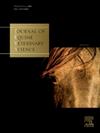Does the equilibration time prior to freezing affect post-thaw motion characteristics of stallion spermatozoa?
IF 1.3
3区 农林科学
Q2 VETERINARY SCIENCES
引用次数: 0
Abstract
In stallions, around 20% of ejaculates suffer damage during the freezing process, leading to significant declines in sperm quality. Consequently, numerous studies are dedicated to refining techniques to enhance fertility rates using frozen semen. One factor to consider is the equilibration time, whereby sperm cells are in contact with cooling/ freezing media components at a temperature of 4°C, providing a proper osmotic balance between the intra- and extra-cellular milieu. Our research aimed to assess the impact of preserving semen at 4°C for varying periods (2, 4, or 6 hours) following dilution before freezing, and its subsequent effect on sperm motility after thawing. To achieve this, we collected 16 ejaculates from five stallions. The spermatozoa were separated from the seminal plasma via centrifugation in INRAⓇ 96 medium. After removal of the supernatant, the pellet was mixed with INRA FREEZEⓇ extender at a concentration of 100 million sperm per milliliter. Subsequently, the semen was frozen in 0.5 ml straws after being kept at 4°C (Equilibration) for either 2, 4, or 6 hours. Post-thaw motility and progressive motility were assessed using computer-assisted sperm analysis (CASA). Our results indicate that an equilibration period of 6 hours led to higher percentages of motile spermatozoa after thawing (average of 46.3% P ≤ 0.05), compared to equilibration periods of 4 hours (average of 40%) and 2 hours (average of 33%). Additionally, samples frozen 2 hours after cooling exhibited lower percentages of progressively motile spermatozoa (average of 15.1% P≤ 0.05) compared to samples frozen 4 hours (average 18.8%) and 6 hours (average 20.6 %) after cooling, which showed no significant difference. Based on our initial findings, we suggest that semen should be maintained at 4°C for 6 hours before being frozen to yield higher sperm motility.
冷冻前的平衡时间是否会影响种马精子解冻后的运动特性?
在种马中,大约20%的射精在冷冻过程中受损,导致精子质量显著下降。因此,许多研究致力于改进技术,以提高使用冷冻精液的生育率。需要考虑的一个因素是平衡时间,即精子细胞在4°C的温度下与冷却/冷冻介质组分接触,在细胞内和细胞外环境之间提供适当的渗透平衡。我们的研究旨在评估冷冻前稀释后在4°C下不同时间(2、4或6小时)保存精液的影响,以及解冻后对精子活力的影响。为了达到这个目的,我们从五匹种马身上收集了16次射精。在INRAⓇ96培养基中离心分离精浆中的精子。去除上清后,将微球与INRA FREEZEⓇ扩展剂混合,浓度为每毫升1亿个精子。随后,在4°C(平衡)下保存2、4或6小时后,将精液冷冻在0.5 ml吸管中。使用计算机辅助精子分析(CASA)评估解冻后精子活力和进行性精子活力。结果表明,与4小时(平均为40%)和2小时(平均为33%)相比,6小时的平衡时间使解冻后精子的运动百分比更高(平均为46.3% P≤0.05)。此外,冷冻后2小时的精子进行性运动百分比(平均15.1% P≤0.05)低于冷却后4小时(平均18.8%)和6小时(平均20.6%)的精子进行性运动百分比,差异不显著。根据我们的初步研究结果,我们建议在冷冻前将精液在4°C下保存6小时,以获得更高的精子活力。
本文章由计算机程序翻译,如有差异,请以英文原文为准。
求助全文
约1分钟内获得全文
求助全文
来源期刊

Journal of Equine Veterinary Science
农林科学-兽医学
CiteScore
2.70
自引率
7.70%
发文量
249
审稿时长
77 days
期刊介绍:
Journal of Equine Veterinary Science (JEVS) is an international publication designed for the practicing equine veterinarian, equine researcher, and other equine health care specialist. Published monthly, each issue of JEVS includes original research, reviews, case reports, short communications, and clinical techniques from leaders in the equine veterinary field, covering such topics as laminitis, reproduction, infectious disease, parasitology, behavior, podology, internal medicine, surgery and nutrition.
 求助内容:
求助内容: 应助结果提醒方式:
应助结果提醒方式:


